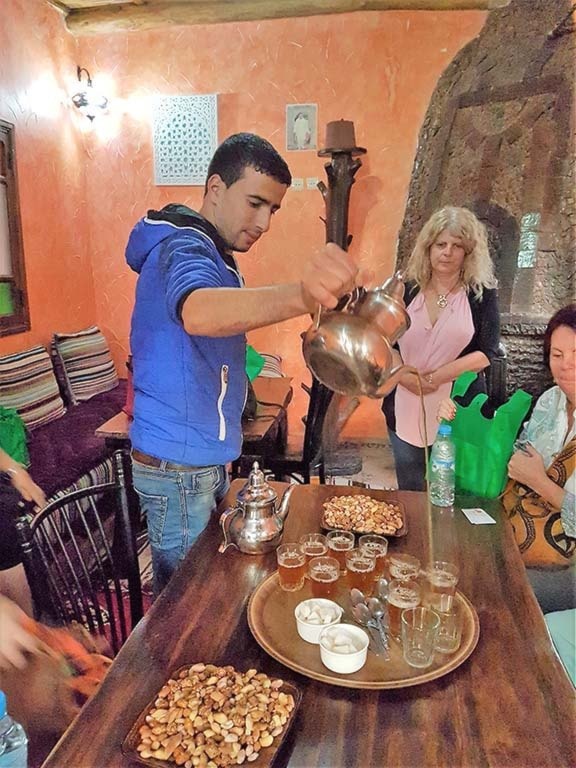Carla Nelson
Once you leave the coastline of Morocco and head inland, you are going to arrive at a mountain range – the Atlas Mountains. This mountain range runs for 2,500 km through Morocco, Algeria and Tunisia. It separates the coast from the Sahara Desert. The Atlas Mountains are inhabited by Berber people in small villages. The range is separated into the Middle Atlas and High Atlas in Morocco. The highest peak, Mount Toubkal, at 4167m, is located in the High Atlas.
The starting point for most Village and Toubkal treks is Imlil, located 60km south of Marrakech, and home to the Toubkal guides and muleteers. We stayed in a small local lodge just north of Imlil. I was amazed at the tropical rain storms that instantly materialized, only to have bright sun five minutes later! And the evening sunsets were spectacular, then complete darkness except for the moon and stars, and silence. A magical place!
There are many treks available, year round. The typical Mt. Toubkal ascent trek takes 4 days, allowing time to acclimitize. You overnight in tents or gites (small refuges). You have a licenced Berber guide, supported by men with mules to carry food and your overnight packs. You can combine this hike with another and cross over into the desert where you will travel by camel. Toubkal and the Imnan Valley is popular in the winter also, and offers a winter ascent as well as ski tours. You can mountain bike, camel trek, horse trek, rock climb, ski or travel by 4X4 vehicle here. A great destination for adventure travellers!
Leaving the mountains, we headed back towards Marrakech. During the road trip, we grilled our tour guide about life in Morocco. Education is free until university, and is mandatory to age 16 for boys and girls. Boys start working after school very young, but not girls. They stay home and help run the house. Marriages are 'arranged' but boys have 'choice'. When he meets a girl, he brings her to the family, and they take over to see if it is a 'good arrangement'. Married women stay home and raise the children. Although we Western women may think this is oppressive, Moroccan men think that women in their culture have an easy life! They stay home, visit with other women, love to shop and go to the hammam on twice a week. Men in Morocco are workers and the hours are long.
So, what is a hammam you may ask? Basically, it is a public bathhouse, segregated by sex. It involves scrubbing, exfoliation, and lots of argan lotion. It may include a massage or chiropractic treatment. This is a real cultural experience and once you should do! First, you are taken to a change room where you strip down and enter a communal room of other women, lying on mosaic heated benches, and you are attended to by one or more women. They are not gentle. You are instructed – get up, sit down, turn over, stand still – while they dump buckets of alternating warm and cold water on you, lather you up with eucalyptus oil, 'black olive oil soap', and then roughly scrub off all the dead skin with a rough glove — and it comes off! And looks gross! — then slather lanolin lotion back on your body. You then 'cook' for a bit on the heated benches, and then are led to a cooling tub. Following your soak, you are wrapped in a robe, fed mint tea and biscuit, and led to a lounger bed. That's it! That was my experience and this hamman was for 'tourists' so I'm sure other traditional hammans may be less luxurious!
Next week: Marrakech, lslam, and the Fna.
For more information, contact Carla Nelson, Branch Manager, Maritime Travel 250.489.4788. "We Know Travel Best."
